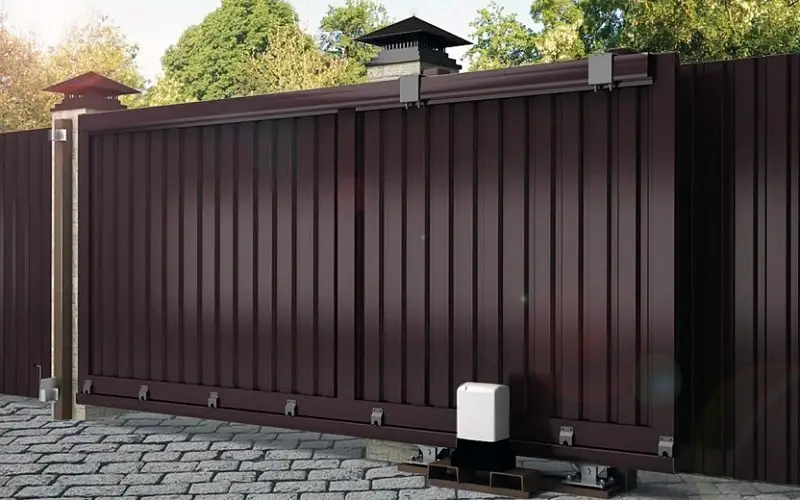A Step-by-Step Troubleshooting Guide for Homeowners and Business Owners
If your automated gate is making squeaks, grinding sounds, or clunking noises while opening or closing, don’t panic — you are not alone. Noisy gates are one of the most common concerns among gate owners and can often be resolved with simple maintenance. Here’s a step-by-step guide to help you diagnose and possibly fix the issue yourself, even if you have limited technical experience.
⚠️ Safety First — Please Read Before Troubleshooting
While this guide provides common areas to check when your gate makes unusual noises, we are not encouraging you to attempt an inspection or repair.
Automated gates are powerful machines that can cause injury if handled improperly. Before you decide to troubleshoot, please consider the following:
Things to Keep in Mind:
- Only inspect or troubleshoot if you feel safe and comfortable.
- Never place your hands near moving parts while the gate is powered.
- Do not attempt to disassemble the motor, control panel, or internal electronics unless you are a trained technician.
- Avoid standing in the gate’s swing or sliding path while testing.
- Always turn off power before performing any hands-on checks, especially near the mechanical or electrical parts.
- Keep children, pets, and bystanders away from the gate during any inspection or testing.
- If you feel unsure at any step, it’s best to stop immediately and contact a qualified gate professional.
✅ Step 1: Identify the Type of Noise
- Different noises often mean different problems:
- Squeaking
- Typically caused by dry hinges, rollers, or chains.
- Grinding
- Could indicate dirt or debris in the tracks, or worn-out rollers.
- Clunking or Banging
- Often due to loose bolts or parts.
- Buzzing or Humming from the Motor
- Could be motor strain, electrical problems, or obstruction.
Safety Tip:
If the sound is coming directly from the motor, be cautious — don’t open the motor cover unless you are trained.
✅ Step 2: Perform a Visual Inspection
- Walk along the entire gate path:
- Look for branches, rocks, leaves, or debris.
- Inspect all moving parts:
- Rollers, hinges, chains, and pivot points.
- Check for:
- Rust, dirt buildup, bent or loose parts.
- Missing or damaged bolts, screws, or brackets.
- For sliding gates:
- Ensure the gate is correctly seated on the track.
- Check that the track is clear and level.
- For swing gates:
- Check hinges for sagging.
- Confirm arms are securely attached.
✅ Step 3: Lubricate Moving Parts
- Use white lithium grease or a silicone-based lubricant.
- Lubricate:
- Hinges
- Rollers
- Chains
- Sliding tracks
- Avoid regular WD-40 — it is a cleaner, not a proper lubricant.
- Open and close the gate multiple times after lubricating to distribute the lubricant evenly.
Safety Tip:
Wear gloves and eye protection when applying lubricant.
✅ Step 4: Tighten Hardware
- Carefully tighten:
- Loose bolts, nuts, and brackets.
- Check:
- Chain tension (not too loose or tight).
- Hinge bolts to ensure the gate isn’t wobbling.
Safety Tip:
Do not overtighten bolts — overtightening can cause damage, especially on aluminum gates.
✅ Step 5: Inspect the Safety Sensors
- Clean photo-eye sensors with a soft cloth.
- Make sure:
- Sensors are aligned properly.
- Nothing is blocking the beam (cobwebs, leaves, dirt).
Safety Tip:
Avoid adjusting electrical components unless you are confident.
✅ Step 6: Check for Proper Gate Balance
- Gently test the gate’s movement (if it’s safe to do so):
- Disconnect it from the motor (check your manual first).
- The gate should move smoothly without dragging or sticking.
Safety Tip:
If the gate feels heavy, stuck, or off-balance — do not force it
✅ Step 7: Reset the Gate System
- Some gates allow a simple reset:
- Turn the power off for 30 seconds, then turn it back on.
- Refer to your owner’s manual for reset instructions.
✅ Step 8: Test the Gate Again
- After cleaning, lubricating, and tightening:
- Operate the gate.
- Listen for improvement.
✅ Bonus Tips for Safe & Cost-Effective Maintenance
- Keep a Maintenance Log
- Track when you inspect, lubricate, and service the gate.
- Use the Right Tools
- Avoid makeshift tools; use proper wrenches, lubricants, and safety equipment.
- Don’t Overreach
- If you can’t safely reach or access a part — stop and call a professional.
- Maintain Regularly
- Doing small maintenance every 2–3 months prevents most major issues.
✅ When to Call a Professional
If you notice:
- Persistent grinding, buzzing, or banging noises
- Broken or worn-out parts
- Motor humming or overheating
- A gate that feels unsafe to operate
It’s time to call an automated gate specialist.




